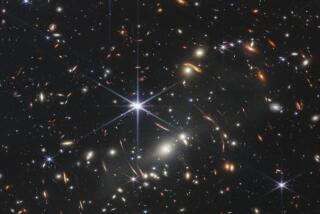At Home in the Universe
- Share via
It’s funny how we talk about “the universe” as if it’s somehow “out there,” the great beyond. Of course, the universe is not beyond us. It’s our own backyard. Granted, it’s a very big backyard, and so it’s nice to have a guide.
“Our Cosmic Habitat” by Martin J. Rees provides what amounts to a pocket guide to the cosmos while “The Universe in a Nutshell,” by his Cambridge University colleague Stephen Hawking, is the illustrated atlas.
Hawking’s book is by far the prettier, but Rees’ is a lot less likely to leave you stumbling in the dark.
So, where do humans fit in the (really) grand scheme of things?
Of what we can see, we occupy a cozy central ground--midway in size between atoms and stars. Galaxies are midway between stars and the observable universe. As for the unobservable universe, well, it may be much bigger than we can suppose, oozing out into new dimensions, back into multiple histories, one of a vast assemblage of universes of which we are a small, if rather special (to us, anyway), part.
And yet, the seemingly removed realms of outer space and inner lives remain tightly connected. “Our existence depends on the propensity of atoms to stick together and to assemble into the complex molecules in all living tissues,” Rees writes. “But the atoms of oxygen and carbon in our bodies were themselves made in faraway stars that lived and died billions of years ago.”
For the most part, he focuses on the big, hard questions and has the courage to crawl way out on a cosmological limb, taking up Einstein’s famous question: Did God have a choice in how He created the universe?
Rees’ answer is an emphatic “Yes!” Other universes with very different laws of nature are not only possible but probable; ours is likely but one in an infinite multiplex where we spin out our lives on a single screen, unaware of the goings-on next door. What’s more, he argues, the multi-universe concept is “already a part of empirical science.”
The one major frustration with the book is that he raises this theme at the opening then doesn’t return to it until the very end. Never mind, other grand themes are sustained satisfyingly from beginning to end. For example: Why is the universe so simple? For such a seemingly complex place, our universe has remarkably few moving parts: three fundamental forces; three families of particles, with fewer than a dozen members each. If current theories are correct, an even simpler reality lies not far beneath, where all particles are aspects of one another and forces are aspects of particles.
It is this simplicity that makes the universe understandable (physics is a lot simpler, say, than the situation in Afghanistan). Or, as Rees puts it: “A star is simpler than an insect.... Biologists, tackling the intricate multilayered structures of butterflies and brains, face tougher challenges than astronomers.” Simplicity gives astronomers the confidence to think they can know what’s going on in distant worlds: Helium is helium and gravity is gravity everywhere in our cosmos.
In the beginning, the universe was simpler still--a single note that somehow, variation on theme, grew from nothing at all into all we see, like a forest from a seed. Where did the forces and particles and dimensions and cosmologists all come from? “For science, the overarching problem is to understand how a genesis event so simple that it can be described by a short recipe seems to have led, 13 billion years later, to the complex cosmos of which we are a part.”
Today, our universe is inhabited by some undeniably odd ducks: Some of these, like black holes, are the only place to study “extreme physics.” Others, like “dark matter,” remain unidentified, even though, whatever it is, it makes up most of the universe, accounts for the existence of galaxies (and life) and determines our ultimate fate. The one thing we do know is that dark matter is not like us. “Particle chauvinism has to go,” writes Rees. “We’re not made of the dominant stuff in the universe.”
Rees provides a nice summary of how we got here, how the universe began and how it might end. This big backyard of ours had a most unlikely origin. It apparently sprang into being from a very energetic speck of empty space, then puffed itself up explosively, stretching small jitters of uncertainty into the structures that became strings of galaxies, crowded with stars and planets, the rest. All this is pretty well understood back to the Big Bang, about one millisecond into creation.
What is not known, however, is how or why the Big Bang banged. Why are those particular laws at work? Why that mix of energy and particles? Were there many such bangs, each different in some essential way?
If the past is hazy, the future is equally indeterminate. After the stars burn out, atoms decay and black holes evaporate, the universe may simply dilute itself into oblivion, melting memories of our existence in the process.
There goes the neighborhood.
Lay readers will appreciate Rees’ clear, uncomplicated prose, even when dealing with tough stuff that leaves most physicists tongue-tied. Most welcome of all, he explains how scientists know what they claim to know. Why should we believe in dark matter if we can’t see it? How do you know that a typical star contains 1057 protons? How can anyone say what the universe was up to a millisecond after its birth?
The organization of Rees’ “Our Cosmic Habitat” is a little muddled--not surprising for a book based on a series of lectures at Princeton. Things fly by, sometimes more than once: time travel, life on other worlds, religion, history. To some readers, it might present a kaleidoscope of disconnected images--a blur like houses and trees rushing past a fast-moving train. On the other hand, there’s nothing like a train trip to give you the lay of the land, a sense of the topology, the relation of parts to the whole.
Hawking’s new book, on the other hand, is unlikely to make sense to anyone who doesn’t already know the plot line. Although this supposedly user-friendly companion to his previous bestseller promises to offer “The Universe in a Nutshell,” it’s more like a sprint through the most difficult ideas in physics without a gasp for breath: Vacuum fluctuations, Grassman numbers, the cosmological constant, imaginary time, information loss in black holes, the holographic universe. Whew! And all this before the end of Chapter 2!
Explaining, however, has never been Hawking’s forte. Charm is. And he hasn’t lost an ounce of that. He still has his sly humor and love of puns. “Our past is pear-shaped,” he concludes one section. Chapter 5 ends: “You might wonder if this chapter is part of a government cover-up on time travel. You might be right.”
Hawking’s obvious delight in the universe makes him a delight to read, even when you don’t understand what he’s saying. Besides, the lavish illustrations are so intelligent that they carry the text.
So what is the universe in a nutshell? Assume that our universe “lives” on a brane, or membrane, that lies within a higher-dimensional space; its history, Hawking says, would be “a four-dimensional sphere that would be the boundary of a five-dimensional bubble with the remaining five or six dimensions curled up very small.”
On a perfectly smooth brane, galaxies would not have formed and life could not exist. But a brane wrinkled like a nutshell will do nicely, providing the irregularities essential for an inhabited universe. Thus, Hawking concludes, “it is only the slightly hairy nutshells which will be observed by intelligent beings asking why the origin of the universe wasn’t perfectly smooth.”
Perfectly clear?
Unlike Rees, Hawking refers to many concepts he never explains: subtracting infinities, for example, or fine-tuning a constant, or symmetrical solutions to equations. On the other hand, Hawking offers the best explanations of some very tricky concepts, including particle spin, power spectrum, wave functions and how black holes can be described in terms of “branes.” He also explores some vitally important ones--for example, the unsustainability of that economic growth politicians love so much. If consumption of electricity grows at present rates, he points out, by the year 2600, the Earth would “glow red-hot.”
And he shares with Rees the cockeyed optimism that the human race will endure, even if it has to travel to the stars to do so. “I don’t believe the human race has come so far just to snuff itself out when things are getting interesting,” Hawking writes.
Not surprisingly, he’s clearest when explaining themes farthest removed from his own research. The discussion of how extra dimensions might solve some of physics’ thorniest questions is lucid and timely (for example, the idea that gravity is weak compared to electricity because it somehow “leaks” into unseen dimensions). Like Rees, Hawking explores the idea that our universe is but one of multiple possibilities. The philosophical implications are immense--if somewhat puzzling. On the one hand, we are one in a million. On the other hand, we are one of a million. Ordinary and extraordinary both.
Our universe. You gotta love it. Home sweet home.
*
K.C. Cole is a Times science writer and the author of several books, including “The Hole in the Universe.”
More to Read
Sign up for our Book Club newsletter
Get the latest news, events and more from the Los Angeles Times Book Club, and help us get L.A. reading and talking.
You may occasionally receive promotional content from the Los Angeles Times.










